3. Read the advert again and answer the questions.
(Đọc lại bài quảng cáo và trả lời các câu hỏi.)
1. How far are the Galápagos Islands from the coast of South America?
2. What is special about marine iguanas?
3. What can the people at Tortoise Tours help their customers get?
4. What is the purpose of the ‘leave no trace’ policy?
1. How far are the Galápagos Islands from the coast of South America?
(Quần đảo Galápagos cách bờ biển Nam Mỹ bao xa?)
- They are 1,000 km west of South America.
(Chúng cách Nam Mỹ 1.000 km về phía Tây.)
Thông tin: “The Galápagos Islands are 1,000 km west of South America in the Pacific Ocean.”
(Quần đảo Galápagos cách Nam Mỹ 1.000 km về phía tây ở Thái Bình Dương.)
2. What is special about marine iguanas?
(Cự đà biển có gì đặc biệt?)
- They are a type of lizard that swims in the sea.
(Chúng là một loại thằn lằn bơi ở biển.)
Thông tin: “There are sea lions, too, and marine iguanas, a type of lizard that swims in the sea.”
(Ngoài ra còn có sư tử biển và cự đà biển, một loại thằn lằn bơi ở biển.)
3. What can the people at Tortoise Tours help their customers get?
(Những người ở Tortoise Tours có thể giúp khách hàng của họ nhận được gì?)
- They can help their customers get special permission to spend their holiday in the Galápagos Islands and plan their holiday from start to finish.
(Những người ở đó có thể giúp khách hàng của mình có được sự cho phép đặc biệt để dành kỳ nghỉ của họ ở Quần đảo Galápagos và lên kế hoạch cho kỳ nghỉ của họ từ đầu đến cuối.)
Thông tin: “At Tortoise Tours, we can help you with that! We can also plan your holiday from start to finish – we make it as easy as planning a trip in your own country.”
(Tại Tortoise Tours, chúng tôi có thể giúp bạn điều đó! Chúng tôi cũng có thể lập kế hoạch cho kỳ nghỉ của bạn từ đầu đến cuối - chúng tôi giúp bạn dễ dàng lập kế hoạch cho một chuyến đi ngay tại đất nước của các bạn.)
4. What is the purpose of the ‘leave no trace’ policy?
(Mục đích của chính sách ‘không để lại dấu vết’ là gì?)
- To protect nature from littering, damaging the environment and harming the animals.
(Bảo vệ thiên nhiên khỏi việc xả rác bừa bãi, làm tổn hại đến môi trường và gây hại cho động vật.)
Thông tin: “Please remember that the Galápagos Islands have a ‘leave no trace’ policy to protect nature. This means never drop litter, damage the environment or harm animals.”
(Hãy nhớ rằng Quần đảo Galápagos có chính sách "không để lại dấu vết" để bảo vệ thiên nhiên. Điều này có nghĩa là không bao giờ được thả rác bừa bãi, làm hỏng môi trường hoặc gây hại cho động vật.)

Các bài tập cùng chuyên đề
Bài 1 :
An eco-friendly fieldtrip to Phong Nha Cave
1. Listen and read.
(Nghe và đọc.)
Ms Hoa: Listen, everyone! This year, we’re going on a fieldtrip to Phong Nha Cave, a tourist attraction in Quang Binh Province.
Class: Hooray!
Nam: I hope I can find some small pieces of stalactites. If I add some to my rock collection, it will be the best at school.
Mai: I’ll buy a lot of snacks to share. We’ll have fun!
Ms Hoa: We will have fun, but in a different way. This time, the fieldtrip is going to be eco-friendly.
Nam: Ms Hoa, what’s an eco-friendly fieldtrip?
Ms Hoa: Going on an eco-friendly fieldtrip means we’ll enjoy, explore and learn about the place, but in a way that will not damage it. So, Nam, I’m afraid you can’t take any stalactites because it takes hundreds or sometimes thousands of years for them to form.
Nam: Wow! I didn’t know that. I won’t even touch them, I promise.
Mai: But can we bring snacks?
Ms Hoa: Yes, but if I were you, I wouldn’t bring too many snacks. We don’t want to leave litter behind and damage the environment.
Mai: I agree. I’ll also try to bring snacks with less packaging.
Ms Hoa: That’s a good idea. Let’s hope our fieldtrip will be a fun educational experience for everyone.
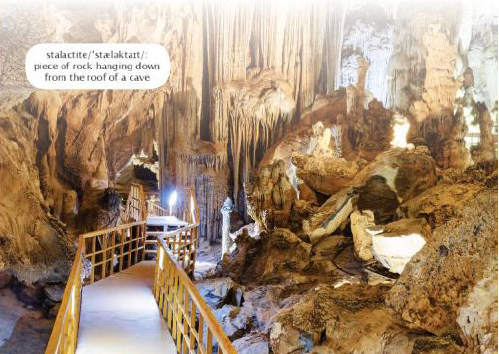
Bài 2 :
2. Read the conversation again. Then find and correct a mistake in each sentence below.
(Đọc lại đoạn hội thoại. Sau đó tìm và sửa lỗi sai trong mỗi câu dưới đây.)
Example:
Nam and Mai’s class are going on an eco-friendly fieldtrip to Ha Long Bay. => Phong Nha Cave
(Lớp của Nam và Mai sẽ tham gia một chuyến dã ngoại thân thiện với môi trường đến Vịnh Hạ Long. => Động Phong Nha)
1. On an eco-friendly fieldtrip, tourists enjoy, explore and damage the environment.
2. Nam will take pieces of stalactites because they take a long time to form.
3. Mai will bring snacks with a lot of packaging on the trip.
Bài 3 :
3. Put each phrase into the correct column.
(Đặt từng cụm từ vào cột đúng.)
explore the place
damage the environment
leave litter behind
learn about the place
|
Dos |
Don’ts |
Bài 4 :
4. Complete these sentences from 1.
(Hoàn thành các câu sau từ bài 1.)
1. Nam says, ‘If I _______ some to my rock collection, it _______ the best at school!’
2. Ms Hoa says, ‘If I ________ you, I _______ bring too many snacks.’
Bài 5 :
2. Read the brochures below. Then work in pairs to solve the crossword using words from the brochures.
(Đọc các cẩm nang dưới đây. Sau đó làm việc theo cặp để giải ô chữ bằng cách sử dụng các từ trong tờ quảng cáo.)
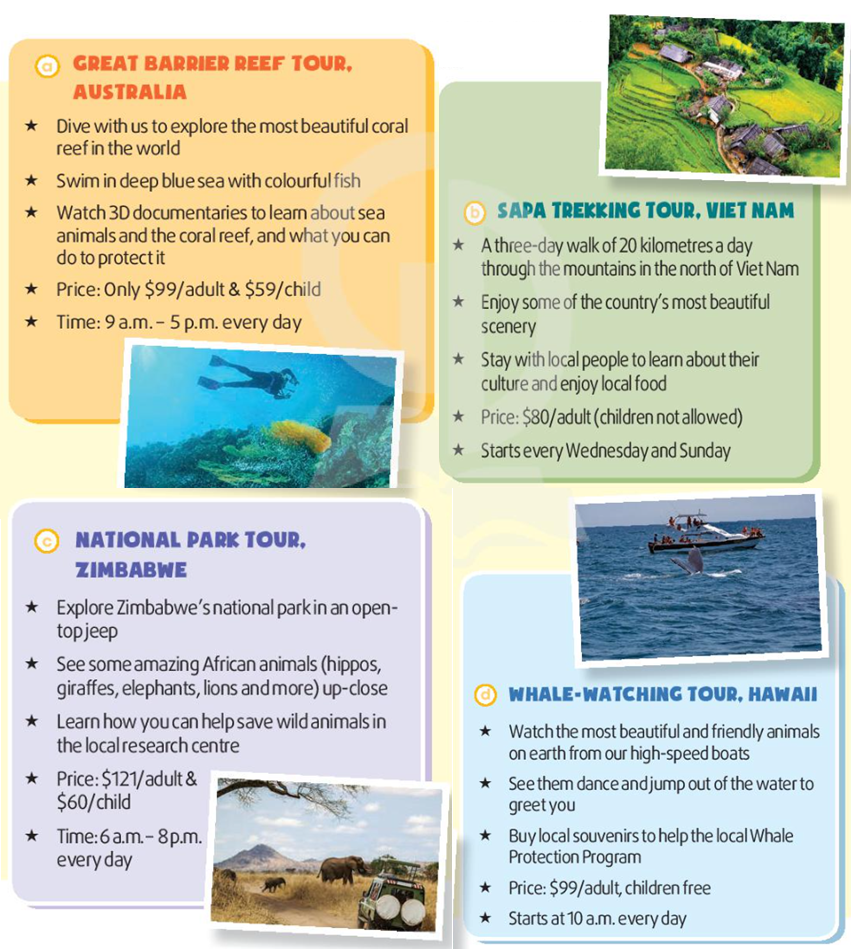
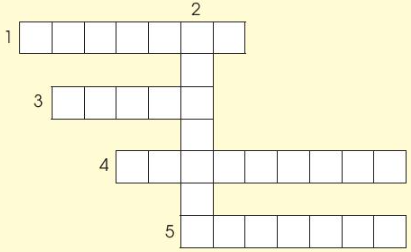
ACROSS
1. (v) to keep something safe from damage or harm (Brochure a)
3. (adj) connected with the place you are living (Brochure b)
4. (n) things you buy or keep to remind yourself of a place or holiday (Brochure d)
5. (v) to find more about a place (Brochures a and c)
DOWN
2. (n) the way of life of a group of people or countries (Brochure b)
Bài 6 :
3. Which tour does each statement below talk about? Write a, b, c, or d.
(Mỗi câu dưới đây nói về chuyến tham quan nào? Viết a, b, c hoặc d.)
1. You can buy arts and crafts to help protect the environment. _______
2. You can learn how to help protect wildlife. _______
3. This tour is not suitable for families with children. _______
4. This tour offers educational videos about the environment. _______
Bài 7 :
1. Read the text below and fill in each gap in the table below with ONE of the highlighted words from the text.
(Đọc văn bản dưới đây và điền vào mỗi khoảng trống trong bảng bên dưới bằng MỘT trong các từ được đánh dấu từ văn bản.)
Environmental Impact of Tourism
Although tourism is often called 'the smokeless industry', or an environmentally-friendly industry, it can actually damage nature. However, different kinds of tourism may have different effects on the environment.
• Mass tourism is a kind of tourism which involves tens of thousands of people crowding the same places at the same time of year. It often has a lot of negative impact on the local area, such as litter from tourists and pollution from traffic.
• Ecotourism provides tourists with opportunities to explore nature, and at the same time helps protect the environment and educates travellers on local environmental issues. It also promotes tourists' respect for local communities.
• Sustainable tourism involves not only environmental protection and cultural respect, but also efforts to keep profits local. It often refers to actions of the tourist industry as a whole.
• Responsible tourism encourages tourists to be more than visitors. Responsible tourists should not only be aware of their role, but also take part in protecting the environment, culture and improving the profits for local people. Responsible tourism often relates to specific actions of individuals, businesses, and communities.
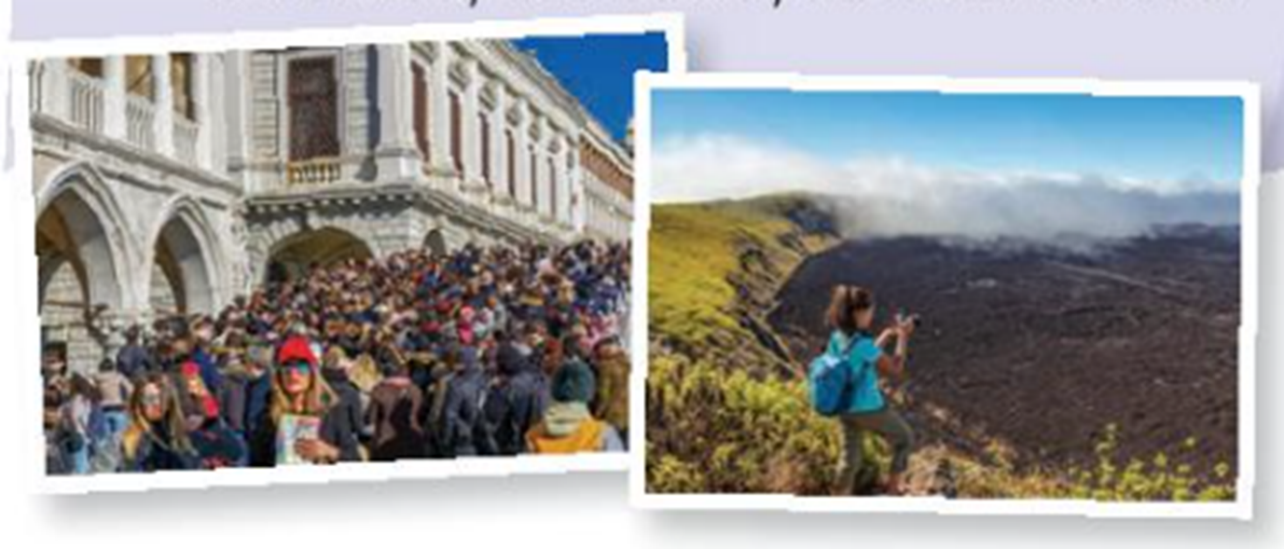
|
Negative impact |
Positive impact |
|
(1) __________ |
(2) __________ (3) __________ (4) __________ |
Bài 8 :
2. Which kind of tourism does each description below fit best? Tick (✓) the appropriate column.
(Mỗi mô tả dưới đây phù hợp nhất với loại hình du lịch nào? Đánh dấu (✓) vào cột thích hợp.)
|
Mass tourism |
Ecotourism |
Sustainable tourism |
Responsible tourism |
|
|
1. It attracts many tourists at the same time. |
||||
|
2. It stresses the active role and specific actions of visitors in saving the environment. |
||||
|
3. It stresses the role of the whole tourist industry. |
Bài 9 :
1. Read the text. Match the highlighted words with their meanings.
(Đọc văn bản. Nối các từ được làm nổi bật với nghĩa của chúng.)
The more people travel, the bigger impact they may have on the environment. How can we reduce it while travelling? Here are some advice.
Reduce your carbon footprint while travelling. Since flying produces more carbon footprint than any other means of transport, you should only fly when the trip is long. During the trip, you should walk, cycle or use public transport as much as you can. This not only helps to keep the environment clean, but also allows you to enjoy the beauty of nature and interact with local people.
Choose eco-friendly activities that benefit animals and the ecosystem. Avoid activities that allow you to touch or ride animals because they disturb their natural patterns and attract many people. Instead, visit wildlife parks or organic farms. These will help you understand and respect the nature more and stop doing things that harm the environment.
|
Words |
Meanings |
|
1. interact |
a. to be good for someone or something |
|
2. benefit |
b. to talk or do things with other people |
|
3. disturb |
c. to interrupt what people are doing and make them angry |
Bài 10 :
2. Read the text again and choose the best answers.
(Đọc lại văn bản và chọn câu trả lời đúng nhất.)
1. What is the main idea of the text?
A. Reducing the environmental impact of tourism
B. Visiting wildlife parks
C. Choosing suitable tourist attractions
2. An easy way to reduce your carbon footprint is to _________.
A. fly when you travel
B. walk when you arrive at the place
C. ride animals
3. What can be inferred from the text?
A. Tourists are encouraged to watch the shows which are performed by animals.
B. Visits to organic farms or wildlife parks can be harmful to the environment.
C. Tourists should choose activities that are good for local people and the environment.
Bài 11 :
1. Read the postcard. Can you identify the country?
(Đọc bưu thiếp. Bạn có thể xác định đất nước không?)
Dear Jenny,
We’ve been in Hue for three days. What an amazing city! The weather has been wonderful, and we’ve been to a lot of tourist attractions. I’ve visited the Tomb of Khai Dinh and I’ve even gone boating on the Perfume River. I’ve bought a souvenir. Have you missed me?
Love,
Ella
P.S. I had a text from Dylan. He’s passed his driving test!
Bài 12 :
2. Read the advert. For questions (1–3), choose the correct answer (A, B or C).
(Đọc đoạn quảng cáo. Đối với câu hỏi (1–3), chọn câu trả lời đúng (A, B hoặc C).)
1. The Galápagos Islands are home to _____ .
A the world’s largest tortoises
B the only lizard that can swim
C many different types of penguins
2. Visitors to the Galápagos Islands need _____ .
A a tour company to organise their holiday
B to have special permission to visit
C to plan their trip in their country
3. Visitors to the Galápagos Islands should _____ .
A try to change things for the better
B recycle all the rubbish that is there
C leave the islands as they found them
Bài 13 :
3. Listen and read the dialogue. What does Sue want to protect?
(Nghe và đọc đoạn hội thoại. Sue muốn bảo vệ cái gì?)
Sue: I visited the castle yesterday. It’s so beautiful, but no one looks after it. What can we do to protect it?
Ben: My advice is not to take souvenirs, like pieces of stone, from the castle.
Sue: Good point. Is there anything else I can do?
Ben: Well‚ have you thought about wearing flat shoes with soft soles when you visit? That way‚ you won’t damage the stones.
Sue: That’s good thinking. Thanks!
Bài 14 :
1. Read the email and answer the questions.
(Đọc email và trả lời các câu hỏi.)
Dear Adrian,
Guess what? I’ve just got back from an eco-holiday in Cát Bà National Park on Cát Bà, the largest island in the Cát Bà Archipelago, Vietnam.
The national park is an amazing place. You can go trekking, rock climbing or kayaking, but the best thing about it is the wildlife. I spent most of my time exploring the forests, so I saw lots of animals. My favourite ones were the doucs, a type of monkey. They were lovely and very friendly, but sadly, they are endangered. Seeing them made me even more careful about protecting their home, so I stayed on the trails and didn’t drop litter.
I had a fantastic time in Cát Bà National Park. You should definitely visit if you get the chance! In the meantime, you can check out my photos on Facebook.
Best wishes,
Sebastian
1. What is the email about?
(Email nói về cái gì?)
2. Which paragraph recommends the place?
(Đoạn văn nào tiến cử địa điểm?)
3. What tenses does the writer mostly use? Why?
(Người viết chủ yếu sử dụng những thì nào? Tại sao?)
Bài 15 :
1. Read the title and look at the pictures. What can you see in Ba Bể National Park? Listen and read to find out.
(Đọc tiêu đề và nhìn vào hình ảnh. Bạn có thể nhìn thấy gì ở Vườn Quốc gia Ba Bể? Nghe và đọc để tìm hiểu.)
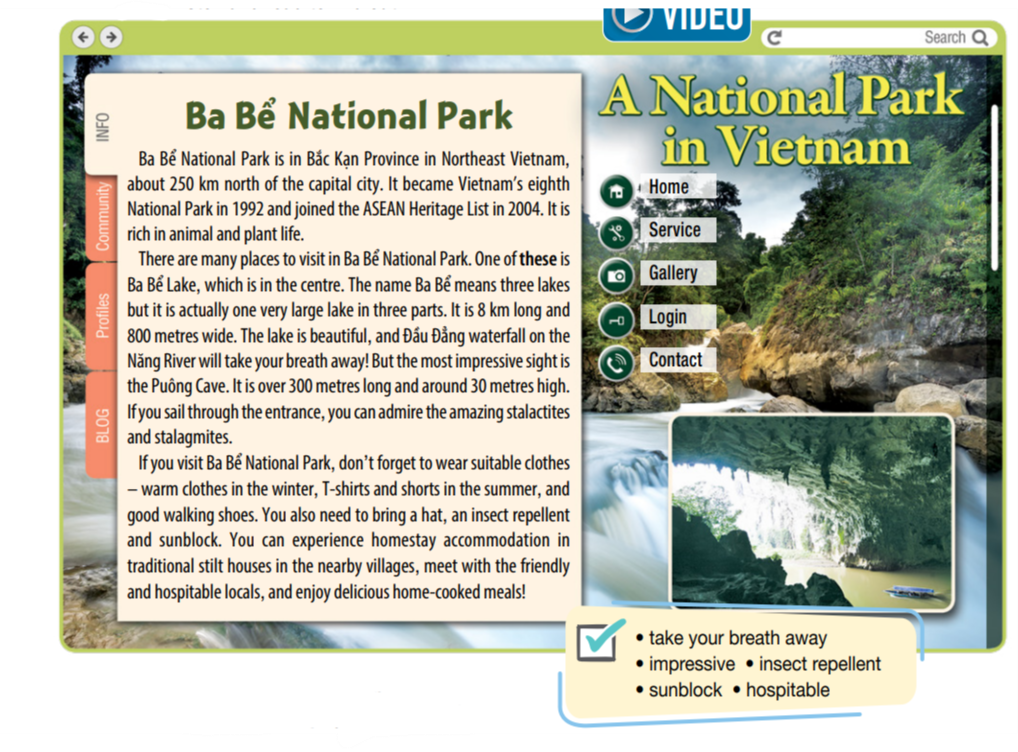
Bài 16 :
2. Read the text again. For questions (1–4), choose the correct answer (A, B, C or D).
(Đọc lại văn bản. Đối với các câu hỏi (1–4), chọn câu trả lời đúng (A, B, C hoặc D).)
1. What is the purpose of the text?
A to provide information about the park’s eco-system
B to explain why the park joined the ASEAN Heritage List
C to educate visitors about the park’s history
D to encourage people to visit the park
2. What does the word “these” in paragraph 2 refer to?
A parks
B lakes
C places
D waterfalls
3. Why does the writer mention the Puông Cave?
A because of its length
B because of its height
C because of its rock formations
D because it’s the best attraction in the park
4. What is NOT true about Ba Bể National Park?
A It has got a range of wildlife.
B Visitors have to cook their own food.
C There is traditional accommodation available.
D The park has got one very large lake.
Bài 17 :
5. Read the article and decide if each of the statements (1–5) is T (true), F (false) or DS (doesn’t say).
(Đọc bài báo và quyết định xem mỗi mệnh đề (1–5) là T (đúng), F (sai) hay DS (không nói).)
Costa Rica is a country full of beautiful wildlife and amazing natural beauty. It’s also a country that’s famous for its eco-tourism and responsible travel options. Here, you can find some of the world’s best eco-tourism destinations where nature and exploration go hand in hand.
There are so many eco-friendly options to choose from! If you’ve ever wondered what it would be like to climb a volcano, then you should visit Arenal Volcano National Park. Close to the town of La Fortuna, the national park is home to hot springs, a lake and an amazing waterfall. If you enjoy sea life more, you can find it all at Ballena Marine National Park. This is one of the best places to go whale-watching and snorkelling. With 8.69 miles of incredible sandy beaches and Central America’s largest coral reef, you’ll never get tired of the wonders under the sea! If you like birds, you’ll find plenty at Corcovado National Park! There are lots of parrots and exotic birds. Forests, swamps and beaches can all be found here. Keep an eye out for rare species like jaguars, sloths and monkeys as well!
For a wonderful holiday that doesn’t harm the natural world, Costa Rica is a brilliant place to visit. In this beautiful country, you can enjoy the breathtaking wildlife and create some magical memories!
1. Costa Rica is world-famous for its eco-tourism destinations. _____
2. Arenal Volcano National Park has different water features. _____
3. Visitors to Ballena Marine National Park can enjoy nine miles of beaches. _____
4. In Corcovado National Park, you can see the world’s biggest species of parrot. _____
5. You can see unusual mammals at Corcovado National Park. _____
Bài 18 :
2 Read the text and mark the statements true (T) or false (F).
(Đọc văn bản và đánh dấu các câu đúng (T) hoặc sai (F).)
ECOTOURISM
We all like to travel, but travelling can harm the environment. As a new type of tourism, ecotourism is now becoming popular. Ecotourists go to unique natural areas. They are exotic places that most of the tourists have never seen, Ecotourists make sure not to harm the environment. They put rubbish in the bins or take their rubbish with them to protect the environment. They even help people in the local communities by offering medical care or teaching English, Ecotourists also support to conserve the environment, Some of the money ecotourists spend helps protect the environment. Here are some common types of ecotours:
+ trekking holidays let tourists make a long journey on foot to remote places.
+ conservation tours let tourists help a local environment and its animals.
+ local community help tours let tourists help local communities.
1. Tourists and ecotourists are the same.
2. Ecotourists do not harm the environment.
3. Ecotourists are careful with their rubbish.
4. There are four common types of ecotours.
5. Trekkers go to remote places.
Bài 19 :
3. Read the definitions below and write correct words / phrases using highlighted words from the text.
(Đọc các định nghĩa bên dưới và viết các từ /cụm từ đúng bằng cách sử dụng các từ được đánh dấu từ văn bản.)
1. ____: unique, unusual and exciting
2. ____: to damage
3. ____: far away from where people live
4. ____: the protection of natural things from being destroyed
5. ____: natural features (plants, animals, weather, etc.) around a place
Bài 20 :
4 Complete the text with the phrases below. There is one extra phrase.
(Hoàn thành văn bản với các cụm từ bên dưới. Có một cụm từ bị thừa.)
|
harm the environment local communities offering medical care put rubbish in the bin conserve the environment |
We must (1) ____for our children and grandchildren. For too many years, people would (2)____ without realising it is bad for our Earth. (3) ____ often don't have enough water or land to grow crops because the environment has been destroyed. We need to help out if we want to conserve different types of plants and animals for future generations. We can all limit waste, use plastic bags and (4) ____.
Bài 21 :
2 Read the text and complete the fact file about Sapa.
(Đọc văn bản và hoàn thành thông tin về Sa Pa.)
Sapa – Beautiful landscapes
Sapa has become a favourite destination for ecotourists. This remote part of Việt Nam is 315 km Northwest of Hà Nội, near the Việt Nam – China border. Sapa is famous for beautiful landscapes of the Fansipan Mountain as well as rainforests and rice fields. The Hàm Rồng area of Sapa is 1,800 metres above sea level. So, it is cool and full of fresh air.
One thing that you should not miss in Sapa is the Hàm Rồng flower garden. It is full of bright-coloured flowers. From the garden, you can take a 30-minute walk to the top of the mountain.
Another place to see is Fansipan, which is known as "The Roof of Indochina ''. It is the highest mountain in the Hoàng Liên Sơn Range. The height of the mountain is 3,143 metres. Fansipan is only 9 km from Sapa town. You can join a trekking tour. It's not an easy trek, but the view from the top of the mountain is worth trying. Trekkers can see beautiful fields of flowers and rainforests. These wilderness areas have not been deforested, so they remain their natural beauty.
Don't forget the locals in Sapa. There are interesting villagers with unique lifestyles. Therefore, spending time in the local villages on your trip is highly recommended.
Please remember that Sapa is indeed beautiful, and we want to keep it that way. So please follow the guidelines that your ecotour leader gives you. We want others to enjoy this special place too.
FACT FILE: SAPA, VIET NAM
1. Distance from Hà Nội: _____km
2. Mountains: _______
3. Hàm Rồng:_______ m above sea level
4. Fansipan: _______ km from Sapa town
5. Fansipan activities: __________
Bài 22 :
3. Read the text again. Which attractions or activities in Sapa should each tourist visit?
(Đọc lại văn bản. Mỗi du khách nên đến những điểm du lịch hay hoạt động nào ở Sapa?)
Minh: I want to see a mountain. Where should I go?
(Tôi muốn nhìn thấy một ngọn núi. Tôi nên đi đâu?)
Đào: I want a place with nice cool air. Where should I go?
(Tôi muốn một nơi có không khí mát mẻ dễ chịu. Tôi nên đi đâu?)
Peter: I want to go on a trekking tour. Where should I go?
(Tôi muốn tham gia một chuyến đi bộ xuyên rừng. Tôi nên đi đâu?)
Mai: I want to see flowers. Where should Igo?
(Tôi muốn ngắm hoa. Tôi nên đi đâu?)
My: I want to see some local villagers. Where should I go?
(Tôi muốn gặp một số dân làng địa phương. Tôi nên đi đâu?)
Bài 23 :
4 Complete the sentences with the highlighted words from the text.
(Hoàn thành các câu với các từ được đánh dấu trong văn bản.)
1. Việt Nam has many beautiful _____ that can attract tourists from foreign countries.
2. He trekked in the _______ for days without seeing another person.
3. This area has not been _______ so wild animals will have a place to live.
4. There is a beautiful _____ from the top of the mountain.
5. Make sure to take your camera, so you can photograph the mountainous _______.
Bài 24 :
1. Read the text. Work in pairs and underline the questions the writer mentioned in the text.
(Đọc văn bản. Làm việc theo cặp và gạch chân những câu hỏi mà người viết đã đề cập trong văn bản.)
I went on a trip to Sapa last November and had a great time. However, during the trip, I fell off a motorbike and broke my arm. Some locals took me to a nearby hospital, where I was surprised to see a young American woman working. She asked: "How did you hurt your arm?"I told her I was admiring the beautiful landscape and rainforest when I fell off my motorbike.
I asked her what she was doing in a hospital in Việt Nam. She was spending a year as a volunteer at a local hospital. She wanted to learn about the village healthcare, so she came to Việt Nam.
After the doctor helped me, the American volunteer asked me where my hotel was. I told her and she arranged someone to take me there.
She told me to stay off motorbikes for a while.
Bài 25 :
1. Read the holiday brochure and say if you would like to visit this place and why.
(Đọc ấn phẩm quảng cáo về kỳ nghỉ và nói xem bạn có muốn đến thăm địa điểm này không và tại sao.)
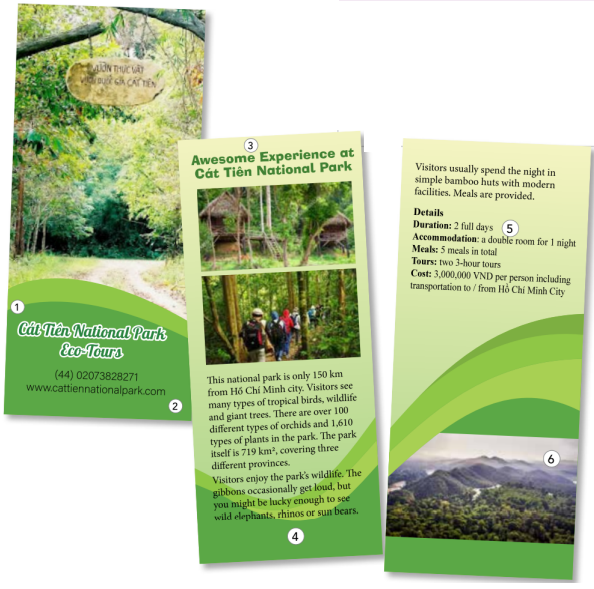
Bài 26 :
2. Read the brochure and answer the questions.
(Đọc tài liệu và trả lời các câu hỏi.)
1. How far is it from Hồ Chí Minh City to Cát Tiên National Park?
(Từ Thành phố Hồ Chí Minh đến Vườn Quốc gia Cát Tiên bao xa?)
2. How many types of orchids does the park have?
(Công viên có bao nhiêu loại lan?)
3. How big is the park?
(Công viên rộng bao nhiêu?)
4. How long is the trip?
(Chuyến đi trong bao lâu?)
5. How much is the trip?
(Giá chuyến đi là bao nhiêu?)
Bài 27 :
4. Fill in the blanks with information from the brochure.
(Điền thông tin từ tài liệu vào chỗ trống.)
This (1)__________ is 150 km from (2) __________.Visitors see (3) __________. There are (4) __________in / at the park. The Park is 719 square kilometers. Visitors enjoy (5)__________.
Bài 28 :
1. Read the text and decide whether the following statements are true (T) or false (F).
(Đọc văn bản và quyết định xem các câu sau là đúng (T) hay sai (F).)
The number of tourists has increased over the years. In 1950, there were only 25 million international tourist arrivals. In 2020, it was estimated that 1.4 billion tourists travelled every year. While tourism is very important to the economy, there is also a price to pay especially in terms of the environment. In fact, the negative impact of tourism on the local environment is huge. Sometimes, the impact is direct, such as when tourists litter the streets or use up natural resources of the local areas such as clean water or energy. Other times, the impact is less direct but still large. When tourists travel for instance, they often travel by planes or vehicles that use a lot of fuel. This damages the environment as well. In either way, tourists are knowingly or not knowingly damaging the environment as they travel. However, it is possible to reduce such negative impact on the environment by traveling more responsibly and in a more eco-friendly way.
|
|
T |
F |
|
1. A suitable tittle for the text would be 'Negative impact of tourism on the economy.’ |
|
|
|
2. In 2020, it was estimated that more than 1 billion people traveled each year. |
|
|
|
3. Tourism is not important for the economy. |
|
|
|
4. Tourists can damage the environment directly or indirectly. |
|
|
|
5. By travelling by plane, tourists can reduce the negative impact of their travel on the environment. |
|
|
|
6. Indirect damage to the environment is not much. |
|
|
|
7. Tourists may be not aware of the damage they are causing to the environment when they travel. |
|
|
|
8. We cannot reduce the negative impact of tourism on the environment. |
|
|
Bài 29 :
2. Read the text and choose the best answers.
(Đọc văn bản và chọn câu trả lời đúng nhất.)
Problems with ecotourism
While ecotourism is often seen as the best way to reduce our negative (1) ________ on the environment, it may also hurt local people and wildlife in certain cases. When tourists visit nature spots and interact with wild animals and nature, they may damage or destroy their natural (2) ________ . In addition, many remote areas require some traveling by car or by plane, which again consumes (3) ________ and increases CO2, emissions in the air. Ecotourism may not benefit local (4) ________, because many local hotels may be owned by international companies and their (5) ________ may not stay in the community. Besides, tourism may increase the cost of living in a certain area, making life more (6) ________ for local people.
1.
A. result
B. impact
C. action
D. opinion
2.
A habits
B. habitats
C. standards
D. environment
3.
A. food
B. money
C. time
D. energy
4.
A. culture
B. economy
C. education
D. environment
5. A. benefits
B. profits
C. businesses
D. payment
6.
A. comfortable
B. expensive
C. eco-friendly
D. convenient
Bài 30 :
3. Read the article. For questions (1-5), choose the correct answer (A, B or C).
(Đọc bài báo. Đối với câu hỏi (1-5), chọn câu trả lời đúng (A, B hoặc C).)
1 York Đôn National Park is NOT located in ____________.
A Krông Na
B Buôn Ma Thuột
C Đắk Lắk
2 How many different types of plants are there in the National Park?
A 40
B 474
C 582
3 The national park covers an area of
A 40 km²
B 474 km²
C 1,155.45 km²
4 The tigers in the park are
A Indochinese
B Indian
C Asian
5 The giant ibis is a type of
A elephant
B cat
C bird
Yok Đôn National Park is one of the biggest national parks in Vietnam. It is in Krông Na commune in Đắk Lắk Province, 40 km northwest of Buôn Ma Thuột City. It is full of beautiful scenery including forests, rivers, streamsnand pools, and amazing wildlife including 474 different plant species in an area of 1,155.45 km².
It is the best place to see large mammals, such as Asian elephants, Indian bison, Eld's deer and yellow crested gibbons. It is also one of the few places that endangered big cats such as the Indochinese tiger and leopard live. Not to mention the wide variety of birds that live there such as the rare giant ibis and sarus crane. All of these species are endangered, so this is why the area is protected and why eco-tourism is important.
Visitors can go trekking. To really make the most of the trip and see as much as possible, treks should be at least three days long. In this way, visitors can trek deep into the forest and visit a local village. Also, they have the chance to enjoy birdwatching and see a lot of other wildlife including bathing elephants.
There are plenty of places to stay and eat around the national park. The best time to visit is during the dry season which is between October and April. This is the time when you are sure to have the best experience ever!

















